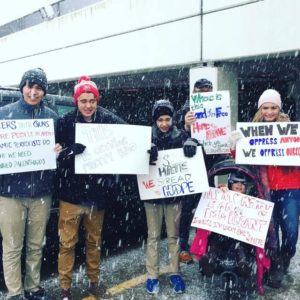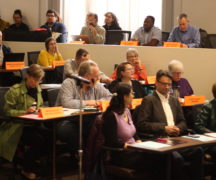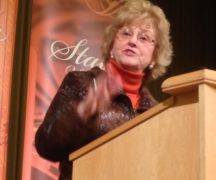By KIRSTY SAYER
BG Independent News
Our van stuffed with kids aged 5 to 16 was light hearted as we brainstormed sign slogans and passed around Sharpies. But as we approached Detroit Metro airport there came inevitable pre-teen groan – “this is going to be so awkward”.
Like any mom with pre-teens and teens, I’m always ready with an annoying comeback to deflect the predictable sighs of the all too horrifying prospect of “awkward”.
“Yeah, maybe, imagine how awkward it must be to be stuck in an airport when you are five and kept away from your mom though? Or hey how about how awkward it must be to go to another country on business and find out you couldn’t return home a week later?
“Besides, it’s good to get out of your comfort zone, and to do stuff with other people in mind. It makes you feel alive. You’ll survive. Let’s go.”
As we approached the airport, the snow started falling heavily and we wondered if we would find that the protest had been downgraded to a few people milling around wondering “if this thing was still on.” Judge Donnelly’s emergency “stay” the night before had led many on the Facebook group to question if the crisis was over and that perhaps we could save our protests for the next outrage.
Others assured us all that people were still being detained in airports, that the stay was incomplete and temporary and that they should come in solidarity with protests being held in different airports. In short, we had no idea what type of crowd we would find after our 75-mile drive.
 As we approached long-term parking we started seeing them. Throngs of people, bundled up, carrying the tell-tale brightly colored signs instead of brief cases or wheeled luggage. The voices in the car reflected relieved enthusiasm. “Look! There are others! Hey check out that sign, that one is good.”
As we approached long-term parking we started seeing them. Throngs of people, bundled up, carrying the tell-tale brightly colored signs instead of brief cases or wheeled luggage. The voices in the car reflected relieved enthusiasm. “Look! There are others! Hey check out that sign, that one is good.”
“OK this might be better than I was imagining, wow there are tons of people”.
That sense of relief. That sense of being united with others against this terrible travesty of justice and humanity was instantaneous. It was visceral, and it grew as we fell in step with so many other groups of people meandering through the parking. And then we heard it, the distant roar. It was just after 4 p.m. and the protest was due to start at 4…could that be? Already? Surely those weren’t people we heard?
Paces quickened as the kids ran to investigate over the edge of the parking balcony. Another great roar. “Mom! There are so many people down there! They are chanting! This is so cool!”
I fiddled with my phone in order to switch it to Facebook live. I wanted to broadcast the protest like so many others I had been watching around the country. I had found so much comfort and solidarity in those. In seeing the goodness. In seeing so many people united. Galvanized into action. I had written a post a few days earlier. Asking the question I had been pondering since after the election. During precarious and terrible times. During unprecedented events. Who will you be? Will you be heroic, doing whatever you can in the scope of your personal capacity? Will you be one of the heroes for those who don’t have a voice? Will you take time away from handwringing at home and ranting on social media? Will you stop looking the other way? Hunkering down and pretending none of this is happening until it starts happening to you? Or will you head off the beast before it gathers too much steam to be stopped? The time to find out who you are going to be is now. It’s go time.
On Sunday our family had other places to be, we had other things to do. It was cold. Some of our kids weren’t particularly enthusiastic about the prospect. But fighting against systemic injustice when we are aware of it is a proud part of our family culture. We are privileged in so many different ways that it might be easy to roll one’s eyes at that statement but this issue is deeply personal to our family. I am an immigrant.
I took the oath to be a citizen of the United States just months ago, in August. Prior to that time I had been the holder of the Green Card.
I had spent more than 20 years in this country, living, working, paying taxes, building up communities, raising five American-born children as a Green Card holder. I could not be differentiated from my neighbors at tax time. I was not exempt. I was not allowed to vote. When I traveled, I traveled with my South African passport. It’s not a particularly powerful passport and many impromptu opportunities to travel have been lost while I waited for visas. After jumping through all the hoops to become a permanent resident – endless questions, interviews, medical tests, affidavits, mountains and mountains of paperwork, lengthy waiting periods, summons for yet more interviews, finger printing, biometric data collecting, fees. fees, yet more fees – the actual citizenship process was fairly straightforward.
It wasn’t a one step deal by any means but it wasn’t fraught with constant complications, more papers, more pictures, more copies, more signatures needed the way the Green card process had been.
I was excited to be able to vote for the first time since I was 18 years old when I had voted in South Africa’s first free and fair election for Nelson Mandela. I was particularly excited to have an American passport. I recall many times having been misinformed over visa requirements, even after double and triple checking being seemingly arbitrarily stopped in airports. My husband, an American citizen, being waved through while I was sequestered in small rooms and in large glass ones. Waiting for what, I almost never knew. Filled with anxiety over missing connecting flights. I never knew what to expect when we would get to customs. On my first attempt to return home as a newly married 19-year-old I found I would not be able to leave the airport. My new husband could leave, but I would have to remain in a small, windowless room for the 21-hour layover. My lack of visa meant I wasn’t granted access to the rest of the airport with its comfortable couches to rest, restaurant, bathrooms. The room where I was to remain smelled strongly of paint. I didn’t know if I would have access to food. The combination of anxiety and the paint triggered an asthma attack. I was granted an emergency visa. For a hefty price.
Strangely, none of this entered my mind when we prepared to go and protest. Until today I hadn’t considered even the painful memories and trauma I went through when my parents and siblings set up a life in California after years of being separated from me, only to be deported 10 months later. With no warning, no time to pack or arrange for long-term care for their dogs, leaving behind everything . Being forced to take shelter with family in South Africa as they rebuilt their lives over there. I was separated from them once again. I hadn’t consciously projected any of my own experiences onto the travel ban until I thought about it today. But it was clearly simmering beneath the surface for me.
When I heard of the five-year-old, detained after who knows what kind of travel experiences, after having endured atrocities which forced his family to flee, that confused, exhausted, possibly sick five-year-old separated from his mom for hours in an airport, my stomach clenched, my heart rate quickened. As a mother I couldn’t imagine the horror of it. But today I’m realizing why this felt so personal. I know how cruel and impersonal these holding areas can be. I know well how stressful borders and customs can be. I know how dehumanizing it can be to be the “wrong nationality” to have the wrong stamp, the wrong passport. You suddenly go from being a warm body with a history and friends and place to a sub human. In an airport, without the right documentation.
As I’ve mentioned before is so arbitrary, you never really know if it will be OK until it meets the scrutiny of your border agent. You can check a hundred times online, you can call and verify, ask your travel agent. Nothing is sure until you get that stamp and are waved on your way. Your money means nothing. Your four little children waiting around the corner, behind a metal barrier, so close that you can hear their excited little voices asking “when will mommy come daddy? Do you think she will like this sign I made for her?” They mean nothing. All that means anything is getting that final stamp. You are often standing with a mass of other bodies, anxiously, impatiently, exhaustedly waiting. It’s so grey, so isolating such a sense of every man woman and child for themselves. Survival mode.
But this sea of people at Detroit Metro on Sunday evening was anything but isolating. It was anything but cold, grey, shuffling and impersonal. It was a vibrant sea of humanity. Everything about it screamed humanity. The warm smiles, the pink hats, the hijabs in every different color. The white suburban moms with their babies strapped to their chests, “refugees welcome” taped to their snuggled up forms. The nervous smiles of the college students huddled together, the silvery hair of the short elderly woman holding a sign high above her head picturing an injured Syrian child next to a familiar photo of Anne Frank. The sign read “She is our Anne Frank”.
We moved to join the crowd but were quickly redirected. “That side is too full, you will need to go down another level and out to the other side.” We were disappointed. We wanted to be part of the vibrant chanting crowd we had just seen from the garage above. We didn’t much want to be alone in the cold on the other side. As we emerged from the airport lounge, what greeted us was an equally large crowd, chanting smiling, waving their signs. “NO BAN! NO WALL!” We moved toward them… “no sorry it’s filling up fast you are going to need to go to the other side of the airport.”
One of my children had drifted ahead, I forged after him, my daughter beside me, I hoped the older boys would follow. Momentarily we were swallowed by the new crowd. I turned on Facebook live. Familiar names joined the feed. Some silently, some thanking us and cheering us on. I tried to get footage of the scope of the crowd and the creativity of the signs. The energy was relaxed and friendly. It was buzzing but low key. The boys found us. My husband and our five-year-old were not as mobile with the jogger stroller. They had not managed to get through, and my husband sent us pictures from where they had finally found a place with another group. They were inside, which seemed like a good place to be with our littlest. It was freezing outside but most people seemed unconcerned.
Eventually my phone died, and we decided to try to join up with my husband and kindergartner. As we tried to get into the building we were stunned. It was completely full. As we stared down the street we saw nothing but people. This gathering had grown exponentially in less than an hour. And it was still growing. The crowd seemed to be multiplying. It was completely diverse. Old and young of every color of every type of dress. The Muslim community was well represented. I noticed a woman kneeling to pray close to the corner where our stroller was parked. People continued to pour in. The mood inside the building was electric. Still friendly but far more intense than it had been when I was filming outside. Against the backdrop of the TV monitors on the baggage carousels carrying stories of Syrian refugees turned back and detained; people marched with their signs of love, inclusion, democracy and resolve. Strangers flashed smiles at each other as they pushed toward new areas. The sense of unity was so profound. The sense of determination was even stronger. “SHOW ME WHAT AMERICA LOOKS LIKE,” bellowed a young African American Man. “THIS IS WHAT AMERICA LOOKS LIKE,” echoed the crowd, over and over again.
For me that crowd was healing. It felt like the envelopment of a warm bath on a freezing day. For the anxious spirits who arrived that day it was a balm. For the pain and fear we held in solidarity and empathy for those affected by this ban it was an outlet. Those folk will not be abandoned by us. The world that has become increasingly unrecognizable to us was righted again during that protest. It was different, and it will never be the same but it was light again. It was not fearful it was not cold, cynical, mercenary, dark and grey. It was bright. It was warm and caring. It throbbed with the energy of love and light and determination. As we made our way back to the car I called to my children, “SHOW ME WHAT DEMOCRACY LOOKS LIKE.” They knew what to say now: “This is what democracy looks like.”
Writing this today, it strikes me what a valuable experience this was for them. What a privilege it was for them. To be part of something so stirring, so humanizing, so inspiring, thought provoking. To have that opportunity to leave the myopic world of self and see the world in terms of others. To join with others for others. To feel empowered to be a part of the solution. These are remarkable times. They call for remarkable actions. This was a remarkable afternoon.




